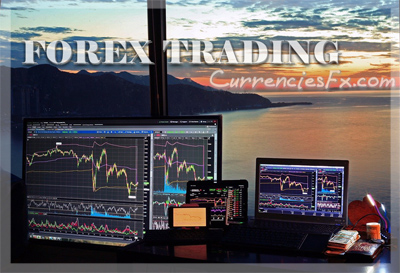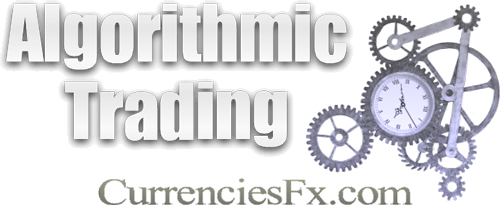Starting with  Forex Trading
Forex Trading
There are a lot of things you need to know before starting to trade in the Foreign Exchange market. It is recommended to learn all the necessary skills and then practice with a free demo account, before trading with real money. A demo account can help you gain experience without any risk of losing your funds. When you are ready to trade for real money, it is better to start by opening a micro-lot account and depositing only a small amount. The Forex market offers opportunities that you can exploit by risking only a limited amount of money.
CurrenciesFx includes a lot of useful educational resources and techniques on how to successfully trade the world's currencies: » There is also CurrenciesFx Lessons section
Learning about the Forex Majors
The Forex Majors refer to the most active and liquid currency pairs and account for about 85% of the total Foreign Exchange market activity.
» Learn about the Forex Majors
The US Dollar Index
USDX is a significant index that measures the overall strength of the US Dollar against the strength of other major Forex Currencies.
Table: Forex Currencies and their weight on the US Dollar Index
|
US DOLLAR INDEX (Basket of Currencies) |
SYMBOL |
WEIGHT (%) |
|
European Euro |
EUR |
57.60% |
|
Japanese Yen |
JPY |
13.60% |
|
British Pound Sterling |
GBP |
11.90% |
|
Canadian Dollar |
CAD |
9.10% |
|
Swedish Krona |
SEK |
4.20% |
|
Swiss Franc |
CHF |
3.60% |
Trading the News & Economic Indicators
News trading is the process of linking new macroeconomic conditions to strong exchange rate movements. Trading the news requires a good understanding of fundamental analysis, certain day-trading skills, and especially elite money-management skills. During important announcements, extreme volatility is very common.
Economic Indicators
Economic indicators are periodic economic statistics that provide insight into the performance of an economy during a certain period. Any change in the macroeconomic conditions can trigger strong movements in the financial markets, and that means profit opportunities for currency traders. News trading is the process of linking macroeconomic events to strong price movements. There are three types based on their timing:
1. Leading Indicator (Before the Economy)
Leading indicators change before the economy changes. A leading indicator can be used as a signal of new upcoming macro conditions. For example, the Consumer Confidence Index and the Home Sales Report.
2. Coincident Indicator (At the same time)
A Coincident Indicator changes at the same time as the economy (i.e. Gross Domestic Product).
3. Lagged Indicator (After the Economy)
A lagged indicator changes 6-10 months after the economy is changing (i.e. the unemployment figures).
» More on News-Trading & Economic Indicators
Technical vs Fundamental Analysis
Undoubtedly, fundamental analysis is the leading method for analyzing the Foreign Exchange Market. However, technical analysis is also useful, especially when selecting the time to enter/exit the market. Reading technical analysis charts is useful for a good number of reasons, including the identification of the trend and the recognition of a major support or resistance level.
Summarizing
- Fundamental analysis can recognize the fair market value of an asset, identify risk, and suggest investment opportunities
- Technical analysis can spot strong price trends and suggest the perfect time to enter and exit the market
» Find Technical Analysis Resources

Forex Signal Services
Forex signals refer to alerts that advise traders to open certain positions in the market. These alerts contain data-based information such as an entry, a take profit, and a stop loss price. Usually, these signals are generated based on TA algorithms that analyze the current market conditions by comparing them to historical price action.
□ Trading signals can be either generated by professional traders or a semi-automated trading system
□ Forex signal services automatically deliver their alerts, however, they do not involve automatic order execution
□ Traders are responsible for executing their orders and applying money management
Highlights
- A signaling service is usually a subscription-based service, but some systems can be purchased once without requiring any subscription later
- The trading signals can be delivered via email, SMS, Audio, or MT4 push notifications
- Any signaling service should provide precise order specifications, not only trade direction
- Initially, it is better to test any system's suggestions on a demo account, before trading for real money
» Compare Forex Signal Services
Automated and Algorithmic Forex Trading
Automated Forex trading is the process of trading 24/5 Forex currencies, without any human intervention. Algorithms analyze market data over multiple timeframes, and when certain conditions are met, trade positions are opened, altered, and closed. The great advantage of automated trading is the elimination of fatigue and emotional/psychological influences. An automated trading system will use a set of pre-established rules to simultaneously manage multiple accounts.

Defining Algorithmic Trading
Algorithmic, Algo, Mechanical, Systematic, or Rule-Based trading, refers to a trading method where order execution is based exclusively on a pre-defined set of rules and instructions.
• Mechanical trading usually involves automatic execution (automated trading), but it can also involve manual execution
• Rules and instructions include variables such as price, time, and volume
The Seven Steps for a Successful Mechanical System
(1) Create a Full Plan with detailed trading goals that are based on your available capital, time, and desired risk exposure
(2) Select a Trade Strategy that can meet the above qualifications and goals
(3) Create Setups (entry/exit conditions including variables such as price, time, and volume)
(4) Build a Money Management System (set of rules and instructions that will determine the stops and the ideal position sizing for each setup)
(5) Test your System and Optimize your Setups (back-testing your system using historical data by optimizing your setups)
(6) Execute Your Trading Strategy (Starting on a Mini Lot Account and then moving on to a Standard Lot Account)
(7) Monitor your Results and Make any Necessary Adjustments (keeping a clean record of the top winning and losing trades)
» More on Algorithmic or Mechanical Forex Trading
■ Getting Started with Trading Resources
CurrenciesFx.com (c)
